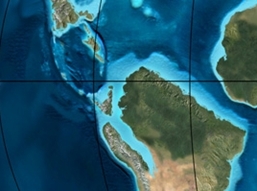Top Qs
Timeline
Chat
Perspective
Simijaca Formation
Geologic formation in Colombia From Wikipedia, the free encyclopedia
Remove ads
The Simijaca Formation (Spanish: Formación Simijaca, K2S, Kss) is a geological formation of the Altiplano Cundiboyacense, Eastern Ranges of the Colombian Andes. The predominantly mudstone formation dates to the Late Cretaceous period; Turonian and Cenomanian epochs, and has a maximum thickness of 693 metres (2,274 ft).
Remove ads
Etymology
The formation was defined and named in 1991 by Ulloa and Rodríguez after Simijaca, Cundinamarca.[1]
Description
Lithologies
The Simijaca Formation is characterised by a sequence of mudstones, grey and black shales with sandstone and limestone intercalations.[1][2]
Stratigraphy and depositional environment
The Simijaca Formation conformably overlies the Chiquinquirá Sandstone, and the Hiló and Pacho Formations, and is overlain by the La Frontera Formation.[3] The age has been estimated to be Turonian,[1] or Cenomanian.[4] Stratigraphically, the formation is time equivalent with the Chipaque Formation.[5] The formation has been deposited in an open marine platform setting.[6] The deposition is represented by a maximum flooding surface.[7]
Remove ads
Outcrops
The Simijaca Formation is apart from its type locality in the Quebrada Don Lope,[2] found at surface in the north of the Bogotá savanna, in the Tabio anticlinal, along the road Ubaté-Carmen de Carupa,[8] at the western and eastern flanks of the Aponsentos-Chiquinquirá Synclinal,[9] near Tena, south of Anolaima and Cachipay,[10] and between Anapoima and Granada.[11]
See also
References
External links
Wikiwand - on
Seamless Wikipedia browsing. On steroids.
Remove ads


